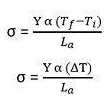What is thermal stress?
In simple words, the meaning of the word thermal is nothing but temperature. So, the stress produced due to a variation in temperature is known as thermal stress. In other words, thermal stress is the force produced per unit area when there is a change in temperature, and it causes changes in the body’s shape or material. Therefore, there will be more stress formed if the temperature is higher.
Definition of stress
American scientist Hans Selye is given credit for his work in the field of stress. He is also popularly known as the father of stress research for his valuable contribution. Stress, in simpler terms, is defined as the restoring force which acts per unit area of the material or body.
How does restoring force come into the action?
Whenever any force is applied to an object, it experiences some deformation. The amount of deformation largely depends on the material with which the object is composed. At times, the deformation is so tiny that it cannot be seen by the naked eye, but whenever a force is applied to an object, some amount of deformation occurs. The object generates a restoring force of the same magnitude in the opposite direction of the applied force.
The restoring force applied in the opposite direction of the applied force is called stress. The deformation due to the temperature change and the restoring force generated because of the change in the temperature is called thermal stress.
The formula of thermal stress
To understand the formula of thermal stress, here are a few variables one needs to understand. Suppose F is the force applied to an object while A stands for the cross-sectional area of the object. The magnitude of stress in the formula is the force applied to the object divided by the cross-sectional area of the object.
Since there is an inevitable change in temperature, which acts as the reason for deformation in the object, thermal stress is the ratio between the forces that act on the body per unit area.
The unit of thermal stress
Since thermal stress, in simple words, is the ratio of the force applied to an object and the cross-sectional area of the object, the SI unit of stress is N/m2. The SI Unit is also known as Pascal (Pa). In addition to that, the dimensional formula of thermal stress is written as ML-1T-2.
How is thermal stress produced?
Thermal stress produced within an object depends on whether it is rapidly heating or cooling itself. In either case, the object can’t maintain the same overall temperature throughout its surface. The reason is that there is a specific variation in the temperature at the initial stage where the object experiences external heating or cooling. Then, due to the sudden heating or cooling, the surface directly in the contact will experience either thermal expansion or contraction.
For example, there is a metallic cylinder to which external heat is added. As the heat is being provided to the cylinder, the external surface of the cylinder will expand while the interior or even the middle portion will not experience significant changes. But with time, the entire cylinder will receive the heat, thus attaining the same temperature as the outer surface. The change in the temperature causes the material to expand. Since there is deformation (the cylinder’s expansion), stress is generated.
To conclude, thermal stress results from thermal expansion or contraction in objects. The thermal expansion coefficient is the deciding factor that determines whether the material will contract or expand. The thermal coefficient is the rate of change in physical dimension because of the variation in temperature of an object. One must note the thermal coefficient since it is different for every material due to the interaction of molecules playing a pivotal role.
The calculation of thermal stress
σ denotes thermal stress. ΔT in the formula of stress plays an essential role as it denotes the change in temperature where Ti is the initial temperature, and Tf is the final temperature. α, on the other hand, denotes the thermal coefficient. Last but not least, Y represents Young’s modulus. Thus, the formula of thermal stress is:
Conclusion
When an object experiences sudden heating or cooling, there is a difference in temperature between the outer and internal surfaces of the object. There is a thermal expansion or contraction based on heating or cooling, thus creating a restoring force known as thermal stress. Thermal stress is greatly affected by temperature.
 Profile
Profile Settings
Settings Refer your friends
Refer your friends Sign out
Sign out





